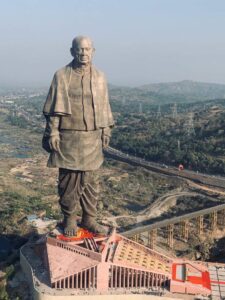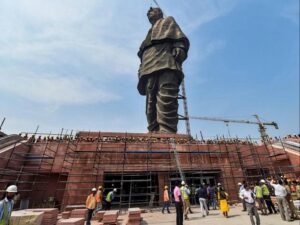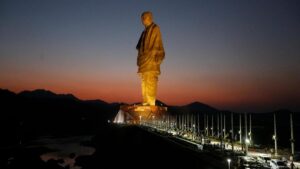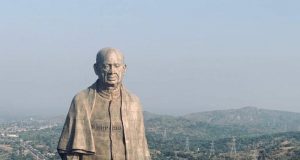Statue of Unity : A Tribute to India’s Engineering Skills
The Statue of Unity is a colossal statue of Indian statesman and independence activist Sardar Vallabhbhai Patel (1875–1950), who was the first Deputy Prime Minister and Home Minister of Independent India and the Chief adherent of Mahatma Gandhi during the non-violent Indian Independence movement. Patel was highly respected for his leadership in uniting 562 princely states of India with a major part of the former British Raj to form the single Union of India. The statue is located in the state of Gujarat, India. It is the world’s tallest statue with a height of (597 ft) 182 metres. It is located on a river facing the Sardar Sarovar Dam on the river Narmada in the Kevadiya colony, 100 kilometres (62 mi) southeast of the city of Vadodara and 150 kilometres (93 mi) from Surat.
The project was first announced in 2010 and the construction of the statue started in October 2013 by Larsen & Toubro, with a total construction cost of Rs 2,989 crores. It was designed by Indian sculptor Ram V. Sutar, and was inaugurated by Indian Prime Minister Narendra Modi on 31 October 2018, the 143rd birth anniversary of Patel.
The Tallest in the World
The Statue of Unity is the world’s tallest statue at 182 metres (597 ft). It rises 54 metres (177 ft) higher than the previous record holder, the Spring Temple Buddha in China’s Henan province. The previous tallest statue in India was the 41 m (135 ft) statue of Hanuman at the Paritala Anjaneya Temple near Vijayawada in the state of Andhra Pradesh. The statue can be seen within a 7 km (4.3 mi) radius.
The ‘Statue of Unity” is the tallest of all notable statues around the world. Some of them are….
- Statue of Unity 240 m (incl. 58 m base)
- Spring Temple Buddha153 m (incl. 25 m pedestal and 20 m throne)
- Laykyun Setkyar, Myanmar, 116m
- Ushiku Daibutsu, Japan, 110m
- Guan Yin of the South Sea of Sanya, China, 108m
- Sendai Daikannon, Japan, 100m
- Peter the Great statue, Russia, 96m
Statue of Liberty, USA 93 m (incl. 47 m pedestal)

Tourist Attraction
This project is situated on the isle of Sadhu-Bet. Located between the Mountain Ranges of Vindhyachal and Satpuda, this monument has many other attractive tourist spots in its proximity such as the Valley of Flowers, the Shoolpaneshwar Sanctuary and sacred temple, the Sardar Sarovar Dam and its water dykes, the scenic Zarvani Falls and majestic palaces of Rajpipla. The grand monument along with a picturesque backdrop makes it an ideal destination for eco-tourism.
Engineering Skills:
The Government of Gujarat had assigned the task of constructing the Statue of Unity to the ‘Sardar Vallabhbhai Patel Rashtriya Ekta Trust’ (SVPRET), chaired by the Hon’ble Chief Minister of Gujarat. SVPRET has executed the project and undertaken all activities related to the construction of Statue of Unity through the Sardar Sarovar Narmada Nigam Ltd (SSNNL).
A high-power Governing Body, headed by the Chief Minister of Gujarat and Executive Committee, headed by the Chief Secretary, Govt. of Gujarat respectively and comprising of other senior Secretaries, take care of various project related decisions.
SVPRET had appointed a consortium comprising Turner Project Management India Pvt Ltd, Meinhardt India Pvt Ltd and Michael Graves & Associates Inc., as PMC (Project Management Consultant). Many of the consortium members have been involved in developing some of the world’s tallest structures, including the Burj Khalifa in Dubai.
SSNNL management team & its engineers have built one of the tallest concrete gravity dams in the world and an irrigation system, which is one of the top irrigation networks of the world.
India’s largest engineering and construction company Larsen & Toubro was assigned the responsibility for designing, engineering, procurement, construction, operation and maintenance of the project.
Larsen & Toubro won the contract on 27 October 2014 for its lowest bid of ₹2,989 crore (equivalent to ₹38 billion or US$540 million in 2019).They commenced the construction on 31 October 2014. In the first phase of the project, ₹1,347 crore were for the main statue, ₹235 crore for the exhibition hall and convention centre, ₹83 crore for the bridge connecting the memorial to the mainland and ₹657 crore for the maintenance of the structure for 15 years after its completion. The Sadhu Bet hillock was flattened from 70 to 55 metres to lay the foundation. L&T employed over 3,000 workers and 250 engineers in the statue’s construction.
Noted sculptor Ram V. Sutar, a Padma Bhushan Awardee, who has created over 40 monumental sculptures over the past 40 years was designated as the sculptor for the Statue of Unity. Commenting on the design, Ram Sutar‘s son, Anil Sutar, explains that “the expression, posture and pose justify the dignity, confidence, iron will as well as kindness that his personality exudes. The head is up, a shawl flung from shoulders and hands are on the side as if he is set to walk”. Three models of the design measuring 3 feet (0.91 m), 18 feet (5.5 m), and 30 feet (9.1 m) were initially created. Once the design of the largest model was approved, a detailed 3D-scan was produced which formed the basis for the bronze cladding cast in a foundry in China.
A countrywide program which covered several villages for ‘Loha Campaign’ were conducted during the year 2013-14. A total of 169,078 used farm tools and soil samples were collected from farmers across the country as their voluntary contribution to the iconic project. In this `Loha Campaign’ which is believed to be one of the largest social mobilization drives in the world, 134.25 metric tonnes of iron was received from villages across the nation. This iron was converted into reinforcement bars weighing 109.17 metric tonnes and used in the construction of the project. Soil collected from various parts of the country was used to make the symbolic ‘Wall of Unity’.
The Statue of Unity stands as a naturalistic and inspirational portrayal of Sardar Patel, donning his characteristic garments and a pose that reflects dignity, confidence, iron will and kindness. Bronze cladding adds richness and visual appeal to the Statue. Sophisticated, state-of-the-art surveying technologies like, Light Detection and Ranging (LIDAR) and Telescopic Logging were used for the construction of the Statue.
The core of the statue used 210,000 cubic metres (7,400,000 cu ft) of cement concrete, 6500 tonnes of structural steel, and 18500 tonnes of reinforced steel. The outer façade is made up of 1700 tonnes of bronze plates and 1850 tonnes of bronze cladding which in turn comprise of 565 macro and 6000 micro panels. The bronze panels were cast in Jiangxi Tongqing Metal Handicrafts Co. Ltd (the TQ Art foundry) in China as large enough facilities were unavailable in India. The bronze panels were transported over sea and then by road to the workshop near the construction site where they were assembled.
Hindustan Zinc was also a part of this project. Three parties have together supplied about 3,300 tonnes of galvanised structural steel and have used about 200 tonnes of Zinc produced by Hindustan Zinc for Galvanisation.

Ador Welding Ltd made several tonnes of flux cored wires type E71T1 for the successful completion of the project. High strength and deposition efficiency electrodes of type E7018 and continuous welding solid wires type ER 70S6 were supplied for high quality structural welding to the contractors working at the site. Satish Bhat, Managing Director, Ador Welding Ltd stated, “The credit also goes to our distribution network that helped us ensure timely deliveries to meet the stringent project deadlines.”
“We are proud to have contributed to yet another milestone project living up to our tradition of nation building in its true essence,” he added.
Engineering Challenges

Wind, Earthquakes
Natural factors like wind and earthquakes posed stiff challenges. Situated right in the middle of the river Narmada, the statue is exposed to the tunnel effect of winds blowing down the river. Studies of wind patterns over the years revealed wind speeds of 39 m per second (roughly translated into 130 km/hr.) could buffet the statue in a worst-case scenario.
The statue has been engineered to withstand wind speeds of up to 50 m per second (almost 180 km/hr.). The challenge is not only of the wind blowing against the statue but the succession effect it creates at the back of the statue that had to considered in the structural design.
To arrest any sway of such a tall structure, two Tuned Mass Dampers of 250 tonnes each have been used. In any given situation, all the four corners of the base raft remain rooted to the ground.
The SoU can also survive earthquakes measuring up to 6.5 on the Richter Scale, at a depth of 10 km and within a radius of 12 km of the statue.

The face
Another challenge came in the form of the look of the statue. Since Patel’s face was an important aspect, special care was taken in casting the facial features that had to be as close as possible to the Sardar’s face. As per the sculptor Ram Sutar’s original design, the statue was to have a poised countenance, with Patel’s head held high and arms by his sides emitting a feeling of power as well as warmth. The statue is also supposed to appear as if it is walking on water, towards the Sardar Sarovar dam, with its left leg slightly forward.The actual features of the Sardar were decided through a participative exercise involving thousands of people. A mock-up was created and exhibited for people to see and comment on it.

Movement of Men and Material
The statue is located amidst remote, mountainous terrain, which posed enormous difficulties in delivery of materials. A temporary Bailey’s bridge connected the hill to the mainland.
The statue base also stands above the highest flood level recorded over a 100-year period of the nearby Narmada dam. A detailed hydrological study was conducted by a specialist consultant to ascertain the river level and flow during various conditions.







